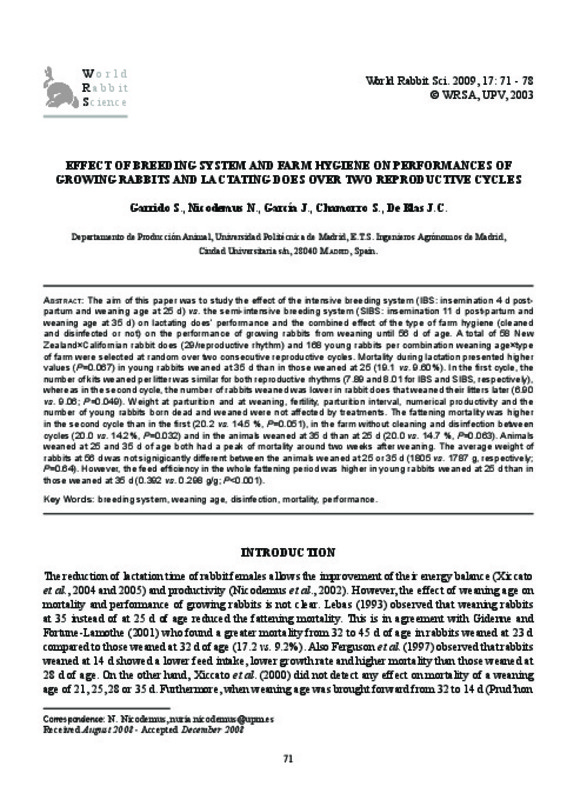JavaScript is disabled for your browser. Some features of this site may not work without it.
Buscar en RiuNet
Listar
Mi cuenta
Estadísticas
Ayuda RiuNet
Admin. UPV
Effect of breeding system and farm hygiene on performances of growing rabbits and lactating does over two reproductive cycles
Mostrar el registro sencillo del ítem
Ficheros en el ítem
| dc.contributor.author | Garrido, S.
|
|
| dc.contributor.author | Nicodemus, N.
|
|
| dc.contributor.author | García, J.
|
|
| dc.contributor.author | Chamorro, S.
|
|
| dc.contributor.author | Blas, J.C. de
|
|
| dc.date.accessioned | 2009-07-27T11:42:12Z | |
| dc.date.available | 2009-07-27T11:42:12Z | |
| dc.date.issued | 2009 | |
| dc.identifier.issn | 1257-5011 | |
| dc.identifier.uri | http://hdl.handle.net/10251/6042 | |
| dc.description.abstract | [EN] The aim of this paper was to study the effect of the intensive breeding system (IBS: insemination 4 d postpartum and weaning age at 25 d) vs. the semi-intensive breeding system (SIBS: insemination 11 d post-partum and weaning age at 35 d) on lactating does' performance and the combined effect of the type of farm hygiene (cleaned and disinfected or not) on the performance of growing rabbits from weaning until 56 d of age. A total of 58 New Zealand x Californian rabbit does (29/reproductive rhythm) and 168 young rabbits per combination weaning age x type of farm were selected at random over two consecutive reproductive cycles. Mortality during lactation presented higher values (P=0.067) in young rabbits weaned at 35 d than in those weaned at 25 (19.1 vs. 9.60%). In the first cycle, the number of kits weaned per litter was similar for both reproductive rhythms (7.89 and 8.01 for IBS and SIBS, respectively), whereas in the second cycle, the number of rabbits weaned was lower in rabbit does that weaned their litters later (6.90 vs. 9.06; P=0.049). Weight at parturition and at weaning, fertility, parturition interval, numerical productivity and the number of young rabbits born dead and weaned were not affected by treatments. The fattening mortality was higher in the second cycle than in the first (20.2 vs. 14.5 %, P=0.051), in the farm without cleaning and disinfection between cycles (20.0 vs. 14.2%, P=0.032) and in the animals weaned at 35 d than at 25 d (20.0 vs. 14.7 %, P=0.063). Animals weaned at 25 and 35 d of age both had a peak of mortality around two weeks after weaning. The average weight of rabbits at 56 d was not significantly different between the animals weaned at 25 or 35 d (1805 vs. 1787 g, respectively; P=0.64). However, the feed efficiency in the whole fattening period was higher in young rabbits weaned at 25 d than in those weaned at 35 d (0.392 vs. 0.298 g/g; P<0.001). | en_EN |
| dc.language | Inglés | en_EN |
| dc.publisher | World Rabbit Science. ICTA. UPV | en_EN |
| dc.relation.ispartof | World Rabbit Science | |
| dc.rights | Reserva de todos los derechos | es_ES |
| dc.subject | Performance | en_EN |
| dc.subject | Mortality | en_EN |
| dc.subject | Disinfection | en_EN |
| dc.subject | Weaning age | en_EN |
| dc.subject | Breeding system | en_EN |
| dc.title | Effect of breeding system and farm hygiene on performances of growing rabbits and lactating does over two reproductive cycles | en_EN |
| dc.type | Artículo | en_EN |
| dc.identifier.doi | 10.4995/wrs.2009.660 | |
| dc.rights.accessRights | Abierto | es_ES |
| dc.description.bibliographicCitation | Garrido, S.; Nicodemus, N.; García, J.; Chamorro, S.; Blas, JD. (2009). Effect of breeding system and farm hygiene on performances of growing rabbits and lactating does over two reproductive cycles. World Rabbit Science. 17(2):71-78. https://doi.org/10.4995/wrs.2009.660 | es_ES |
| dc.relation.publisherversion | https://doi.org/10.4995/wrs.2009.660 | |
| dc.description.upvformatpinicio | 71 | |
| dc.description.upvformatpfin | 78 | |
| dc.description.volume | 17 | |
| dc.description.issue | 2 | |
| dc.identifier.eissn | 1989-8886 | es_ES |








